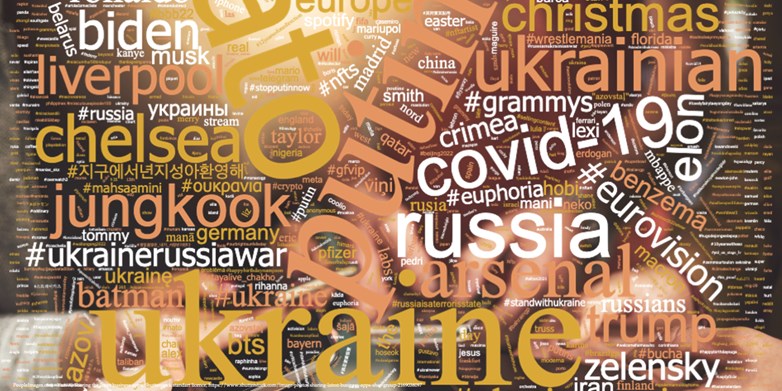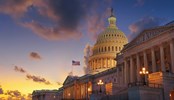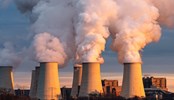Trending? Social media attention on Russia’s war in Ukraine
Russia’s invasion of Ukraine is one of the most important geopolitical events of the 21st century. For almost two years, international news outlets have been covering the war, often providing daily or even hourly updates. But what is the level of public interest and public engagement in countries around the world? When does the war capture an international audience’s attention and what are the events that supplant it? This brief uses data on X (formerly Twitter) trends in 62 countries to address these questions.
The competition for attention is a defining feature of our information landscape. From the relentless stream of social media updates to the myriad of news articles vying for our clicks, individuals are constantly bombarded with information, each competing for a slice of their limited attention. Amidst this cacophony of voices, certain topics rise to the forefront, capturing the collective consciousness and dominating public discourse.
Russia’s war in Ukraine has, for obvious reasons, commanded significant media coverage over the past two years. It has been described as a hybrid war, where conventional military tactics are increasingly combined with non-traditional methods. This includes an information war, fought with narratives to manipulate people’s perceptions, spread falsehoods, or enlist support. To a large extent, this information war has taken place on social media. On the one hand, social media platforms have been used to spread disinformation and propaganda. For example, we’ve seen the spread of false narratives about the causes of the war, the actions of the different parties involved, and the suffering of the Ukrainian people. But on the other hand, social media has also been used to counter this disinformation, with fact-checking initiatives and grassroots efforts to promote accurate information.
This policy brief analyses the prominence of the war in social media discourse. While the content on traditional media outlets provides a snapshot of the supply of information, platforms like X/Twitter offer a unique window into the broader population’s demand for that information and how they evolve over time. Whether or not hashtags related to Russia’s war in Ukraine are trending in a given country, depends not just on the public’s interest in the war relative to other events in the news, but also on the level of interest relative to sport, music, television, and cats. By tracking the prevalence of trending hashtags, we can gain insights into the public’s engagement with Russia’s war in Ukraine, going beyond traditional media narratives and high-level governmental discussions to uncover the conversations and sentiments that shape broader public opinion.
The X/Twitter data suggest that in most countries, social media attention in the Russian war on Ukraine has been short-lived and sporadic. On February 24, 2022, Ukraine-related hashtags were trending in 100 percent of the countries in our dataset. Two weeks later, on March 9, 2022, they were trending in only 3 percent of the countries. We find that geographical proximity to the conflict is a strong predictor of social media interest. Related hashtags trend most frequently in Eastern, Central and Northern Europe. We also document spikes in interest around events that link a country to the war in Ukraine: announcements of military assistance or visits by Ukraine’s President Volodymyr Zelenskyj. Finally, we compare the hashtags trending in NATO countries to those trending in countries that either sided with Russia or abstained from voting in a critical UN resolution and show significant differences between the two groups.
Data and methodology
The source for our dataset is archive.twitter-trending.com – a website that records trending hashtags on X/Twitter across countries and over time. We scrape this website to collect (i) the five highest volume topics in each country on each day and (ii) the five longest-trending topics in each country on each day (these two categories can overlap). Our sample consists of the 62 countries available on the website and covers the timeframe July 2021 to December 2023. From this, we construct a country-by-day panel dataset with 55,862 observations.
We identify 11 topic categories that collectively account for the overwhelming majority of trending topics related to Russia’s war in Ukraine. These topics and their relative frequency are shown in Figure 1. The three dominant categories are “Ukraine”, “Russia” and ”Putin”. We use Google’s translation software to translate non-English tweets which account for a significant fraction of the dataset.
Figure 1. Frequency of hashtags in 11 category topics.
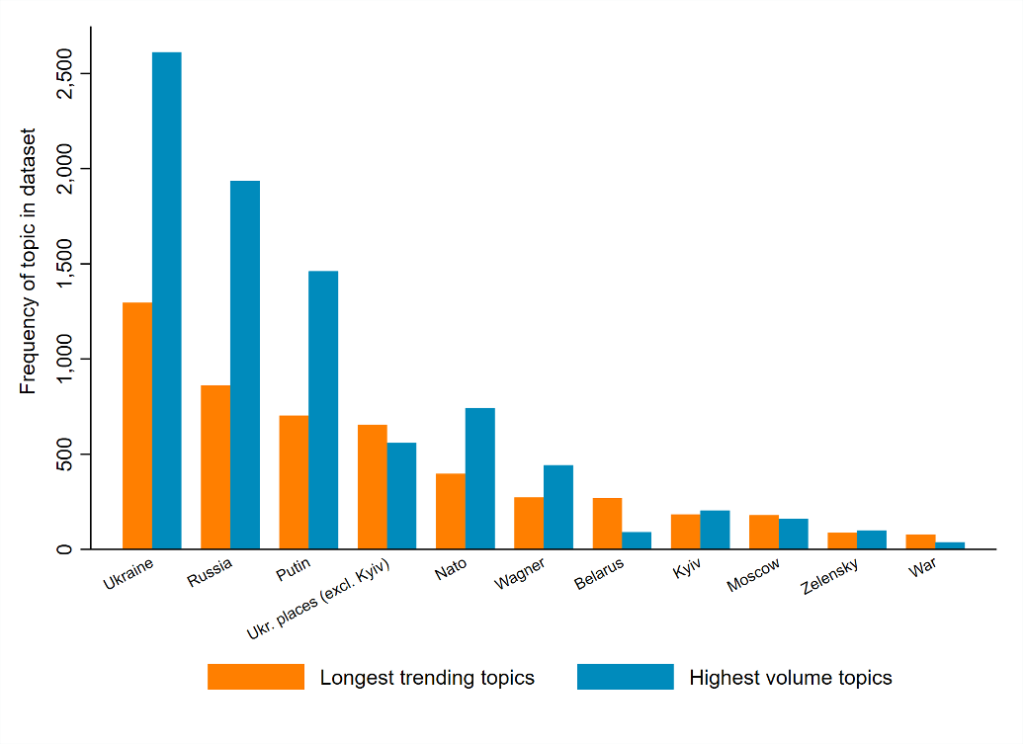
Note: This chart shows the number of times topics assigned to our 11 war-related categories were among the top five longest trending topics (in orange) or the top five highest volume topics (in blue) in any country on any day in our dataset. The source are data scraped from archive.twitter-trending.com
Figure 1 shows that it is more common for war-related topics to be among the highest volume topics on a given day than among the longest trending topics. This suggests that these topics attract a lot of interest in a narrow timeframe (e.g. when news breaks) but are relatively less likely to remain prominent over a whole day. Despite this difference, we find that the distinction between highest-volume and longest-trending does not affect any of the patterns we observe when comparing across countries or time. For simplicity, the results shown below all use the highest-volume measure.
It is important to acknowledge the limitations of the X/Twitter data. Firstly, the population actively using X/Twitter is not representative of the overall population. Secondly, the composition of users may differ across countries which complicates cross-country comparisons. Trending hashtags provide an indicator of public interest that is informative only because we do not have high frequency, nationally representative surveys that are comparable across countries. Finally, we are only able to observe the top-five hashtags in a country on any given day. In principle, a war-related topic could increase in absolute volume from one day to the next, while still being crowded out of the top five.
Geographic variation in attention
Social media attention to the war in Ukraine varies greatly across countries. The map in Figure 2 shows the proportion of days when any hashtag from the considered categories was among the top-five most tweeted, for each country in the database since the start of the war. Interest has, on average, been higher in Europe as well as in Anglo-Saxon countries. In contrast, other regions of the world exhibited less sustained interest, as indicated by the lower frequency of related hashtags among the top-five most tweeted topics.
Figure 2. Prevalence of war-related hashtags.
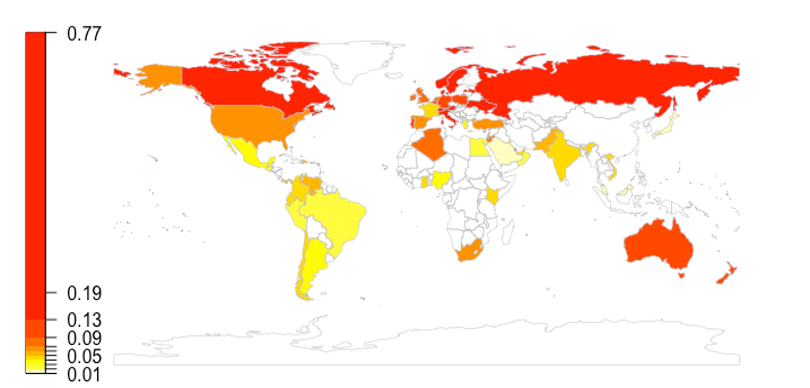
Note: The map shows the share of days on which war-related hashtags (in our 11 categories) were among the top five highest volume topics on X/Twitter between 24/02/2022 and 18/12/2023. Countries in white are not among the 62 countries in the dataset. The source are data scraped from archive.twitter-trending.com
To some extent, this heterogeneity is explained by distance. Figure 3 plots the frequency of war-related trends against geographical proximity to the conflict zone (represented by the distance from each country’s capital to the city of Kharkiv in eastern Ukraine, a major point of focus during the ongoing war). The relationship is clearly negative, suggesting that physical distance from the crisis reduces the intensity of online discourse and public interest. Unsurprisingly, the number of related trends is highest in countries directly or indirectly involved in the conflict – Ukraine, Russia, and Belarus – as well as in Latvia which borders both Russia and Belarus.
Figure 3. Frequency of war-related hashtags and distance from Kharkiv.
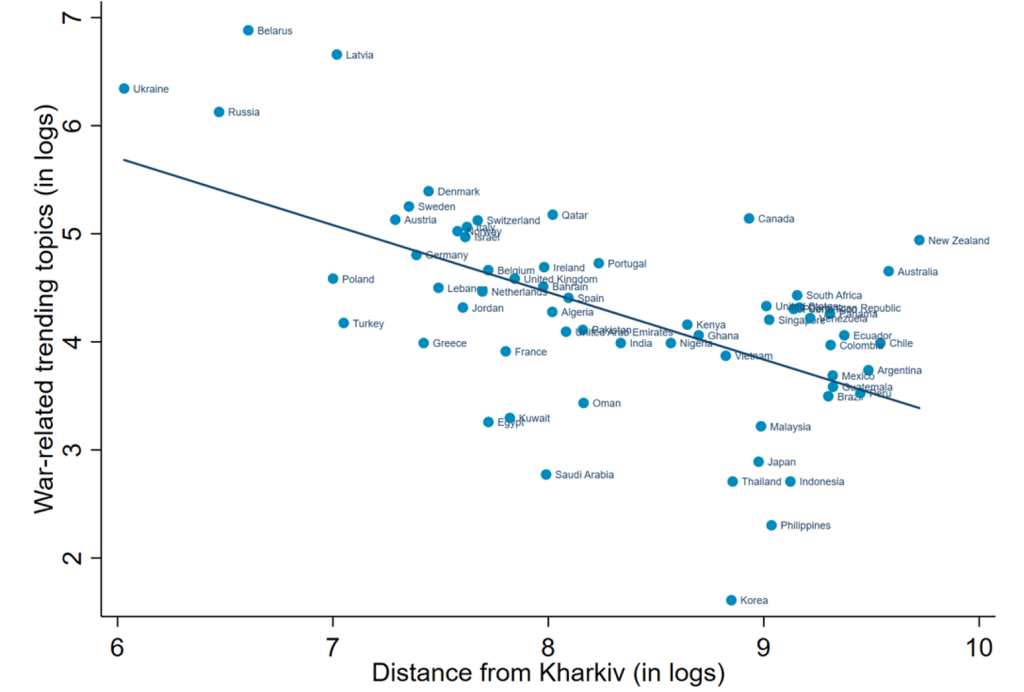
Note: The chart shows the log of the distance from each country’s capital city to the city of Kharkiv in km on the x-axis and the logged frequency of war-related topics among the top five highest volume topics in that country between 24/02/2022 and 18/12/2023 on the y-axis. The source are data scraped from archive.twitter-trending.com
Variation in attention over time
Over the past two years, the war has sustained a relatively high intensity. By contrast, global attention on X/Twitter has been more sporadic, spiking around specific events. This is shown in Figure 4, which plots the day-to-day variation in the number of battle events as recorded by the Armed Conflict Location & Event Data Project (ACLED) (in blue) as well as the share of countries where war-related tweets are trending (in orange). Attention was highest at the time of the invasion in February 2022 and the days of the Wagner Group rebellion in June 2023. Overall, the correlation between twitter trends and conflict intensity is positive but relatively weak.
Figure 4. Frequency of war-related hashtags and intensity of conflict.
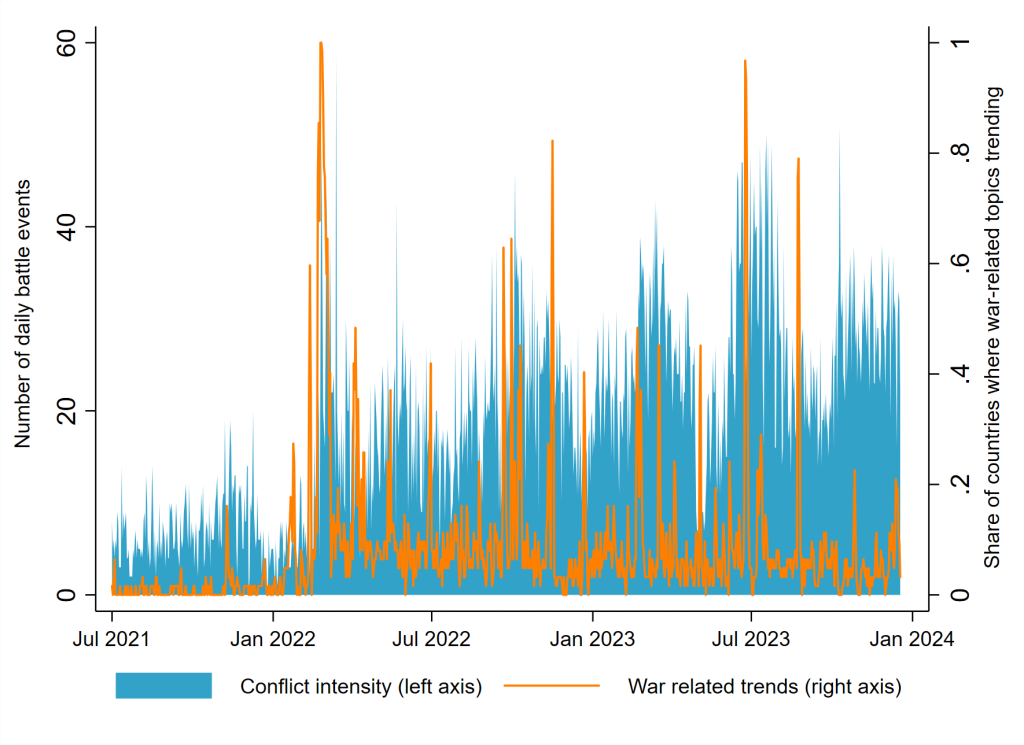
Note: The chart shows the number of daily battle events in Ukraine as classified by ACLED on the left axis (in blue) and the share of countries where war-related topics were trending on the respective day on the right axis (in orange). The sources are ACLED’s Ukraine conflict monitor and data scraped from archive.twitter-trending.com
Attention also reacts to other major global events. Figure 5 compares the number of top-five trending hashtags related to the categories of interest in each country on two specific dates: February 24, 2022, the day of Russia’s full-scale invasion of Ukraine, and October 7, 2023, the day of a Hamas terror attack on Israel. On the day of the Russian invasion, the majority of countries in our sample exhibited the highest value. In contrast, on the day of the Hamas attack, related hashtags were trending almost nowhere outside Ukraine and Russia, indicating that global attention and engagement with this new ongoing crisis significantly overshadowed the focus on the situation in Ukraine. This shift in attention demonstrates how breaking news can capture the public’s interest and divert focus from ongoing crises, affecting the level of engagement on social media and potentially influencing the global response and discourse surrounding these events.
Figure 5. Map of prevalence of war-related hashtags on two different dates.

Note: The maps show the share of the top five highest volume topics on twitter related to Russia’s war on Ukraine. The map on the left shows 24/02/2022 – the day of Russia’s invasion. The map on the right shows 07/10/2023 – the day of a Hamas terror attack on Israel. Countries in white are not among the 62 countries in the dataset. The source are data scraped from archive.twitter-trending.com
While some events impact attention globally, others affect the salience of the conflict for a specific country. Figure 6 shows that people pay more attention to the war when there is a tangible connection to their own country. The panel on the left shows that war-related topics were more likely to trend in a country around the days where the country announced an aid package for Ukraine (military, financial or humanitarian). It shows an increasing trend in the preceding days and a peak on the day of the announcement. The panel on the right shows that war-related topics were more likely to trend in a country around the days of a visit from President Zelenskyj. This effect is large in magnitude but only lasts for around three days.
Figure 6. Likelihood of hashtags trending in relation to country-specific event.
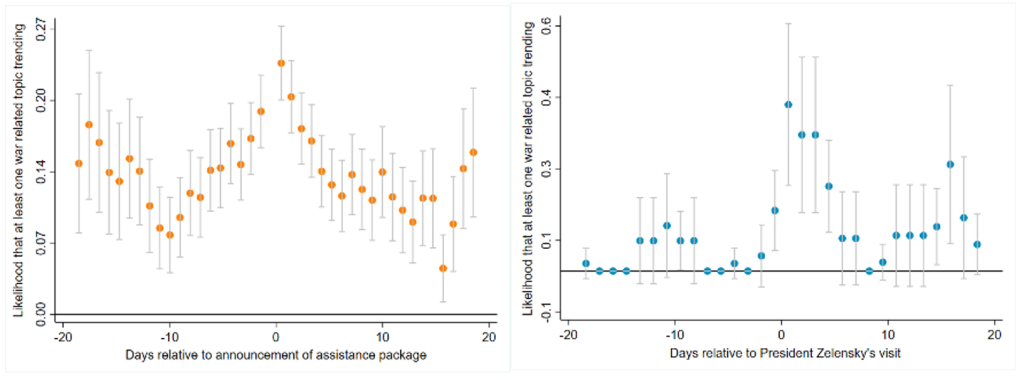
Note: The charts show variation in the share of countries where at least one war-related topic was among the top five highest volume topics on days relative to a specific event. In the left chart, day 0 represents the day on which a country’s government announces an aid package for Ukraine. In the right chart, day 0 represents the day on which President Zelenskyj arrived in a country for an official visit. The source for these charts are: (i) the Kiel Institute’s Ukraine Support Tracker (Trebesch et al., 2023), (ii) Wikipedia’s list of official visits by President Zelenskyj and (iii) data scraped from archive.twitter-trending.com
While the events above act as drivers of attention, it is also interesting to consider what causes war-related topics to drop out of the top five trending topics. We distinguish between two reasons why war-related hashtags could stop trending: (i) a loss of interest that results in a reduction in the absolute number of related tweets (ii) the rise of other topics that displace war-related tweets from the top five. Figure 7 focuses on days where war-related topics dropped out and compares the volume of tweets on the last day where they were in the top five, to the threshold they would have had to surpass in order to make the top five on the subsequent day. In cases where the threshold is lower than the previously observed volume of tweets (a ratio of less than 1), the topic would have kept trending had it sustained its volumes, and one can conclude there was an absolute loss of interest. In cases where the ratio is greater than one, it is possible that the topic sustained its previous volume of tweets but was crowded-out by the rise of a new trending topic. Figure 7plots the histogram of this ratio. 73 percent of the cases are in the first category (loss of attention) and 27 percent are in the possible crowding out category. This provides further evidence to suggest that attention to the war on social media is typically fleeting.
Figure 7. Loss of attention vs crowding out.
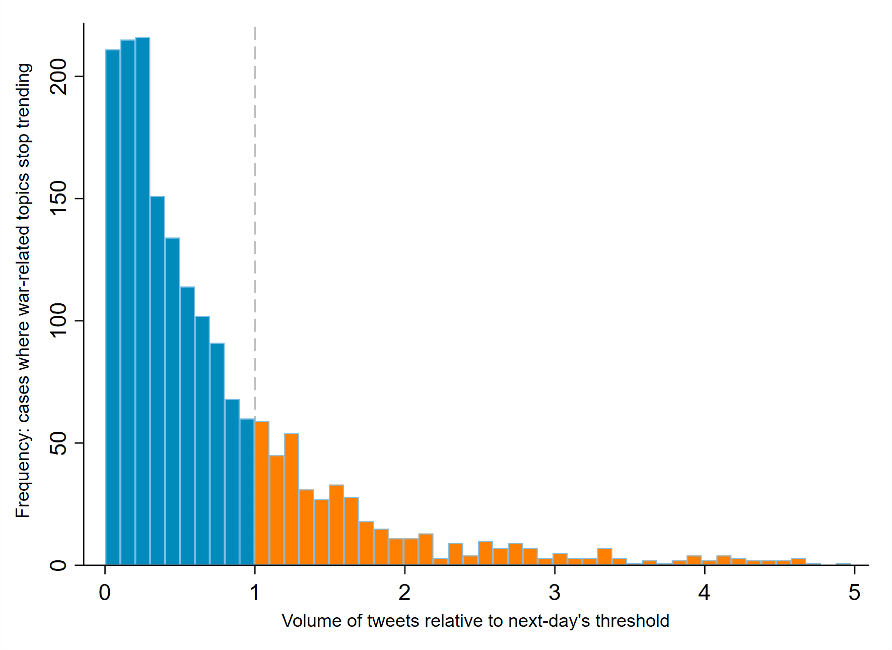
Note: The sample are country-days where war-related topics were among the top five highest-volume topics but then dropped out of the top five the next day. The chart provides a histogram of the ratio of the threshold for making the top five on the subsequent day to the highest volume of tweets of a war-related topic. Values below 1 (in blue) indicate that the volume was above the next day’s threshold and the topic declined in absolute terms. Values above 1 (in orange) indicate that the volume was below the next day’s threshold. The source are data scraped from archive.twitter-trending.com
We also examine the content of discussions on the first day after war-related hashtags drop out of the top five. The word cloud in Figure 8 suggests that on such days, people primarily discuss entertainment topics like music and football.
Figure 8. Word cloud of hashtags trending on days war-related categories drop out.
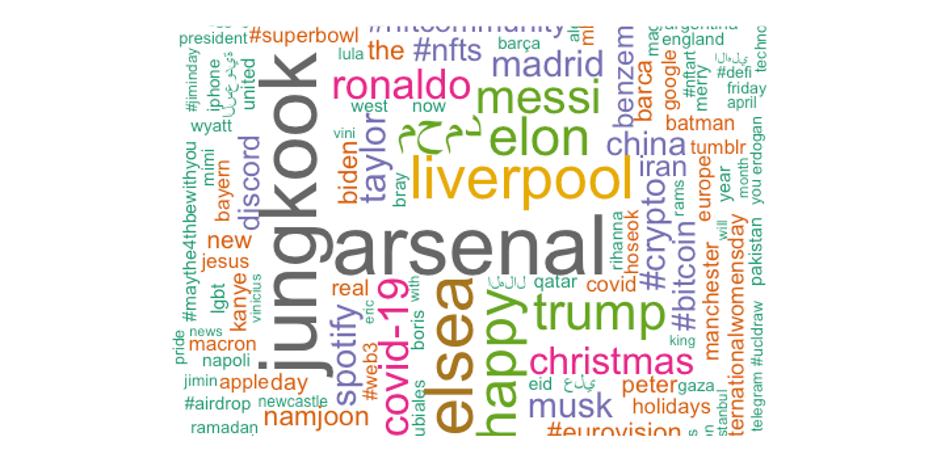
Note: The figure provides a word cloud of trending topics on country-days where no war-related topic was among the top five highest volume topics, but at least one war-related topic had been in the top five on the previous day. The source are data scraped from archive.twitter-trending.com
Content and context of war-related discourse
In addition to providing insight into the level of engagement, hashtag analysis can also reveal the content and context of popular discourse surrounding the war. By examining words trending on the same days as those from our 11 categories, we can gain a better understanding of the topics people are discussing and how the conversation varies across different regions. Figure 9 illustrates this through word clouds, showing the language used in NATO countries on the left and in countries that abstained or voted against the United Nations General Assembly Resolution ES-11/1 on the right. This resolution, dated March 2, 2022, condemned the brutal invasion of Ukraine and demanded that Russia immediately withdraw its forces and comply with international law.
This exercise allows us to compare the dominant themes and narratives in these two groups of countries and observe any differences in public perception and discourse regarding the conflict. The prevalence of cryptocurrency and NFT (non-fungible tokens) references in the word cloud on the right is suggestive of how economic interests and alternative financial systems could be relevant for the positions of countries that abstained or voted against the resolution, and how this might affect their involvement or response to the conflict. On the left, words like “NATO”, ”Biden”, and ”Trump” clearly stand out, suggesting that these topics are central to the discourse on the war in NATO countries. This could indicate a focus on geopolitical alliances, international cooperation, and the role of key political figures in shaping the response to the conflict. Interestingly, “Putin” is very prominent in the left word cloud while “Russia” and “Russian” are more prominent on the right. This could indicate that Putin is seen and discussed as the primary antagonist in NATO countries.
Figure 9. Word cloud of hashtags in NATO countries vs Russia-friendly countries.
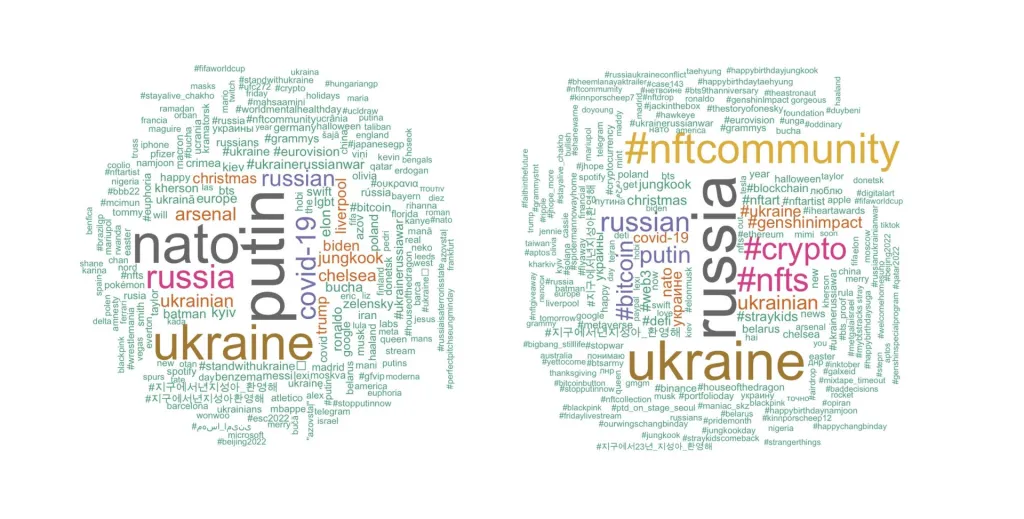
Note: These word clouds represent topics that trend on days where at least one war-related topic is trending in the respective country. The cloud on the left shows NATO countries. The cloud on the right shows countries that either abstained or voted against United Nations General Assembly Resolution ES-11/1. The source are data scraped from archive.twitter-trending.com
Conclusion
This brief uses X/Twitter trends as a barometer of public interest in Russia’s war in Ukraine. We show how attention fluctuates over time in response to developments in the conflict, to other breaking news, and to local events that make the conflict salient for a domestic audience. We also provide descriptive evidence on the variation across geographical regions and among different groups of countries. Additionally, we analyse the instance where Ukraine-related topics stop trending and find suggestive evidence that this is typically due to a gradual loss of interest rather than crowding out by new distracting trends.
Public attention and engagement drive policy in democratic countries, and the sustained support of its democratic allies is vital for Ukraine during this critical time. Understanding the patterns and influences of public attention is crucial for developing effective strategies to sustain engagement and support. This can be achieved for example by regularly highlighting the ongoing significance and bearing of Russia’s war against Ukraine, even as other events dominate the headlines. Emphasizing the impact of the conflict on individuals and communities, as well as its broader implications for international relations and global security, can help sustain public interest and engagement.
References
Disclaimer: Opinions expressed in events, policy briefs, working papers and other publications are those of the authors and/or speakers; they do not necessarily reflect those of SITE, the FREE Network and its research institutes.
Photo: PeopleImages.com - Yuri A, Shutterstock
